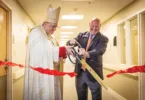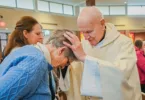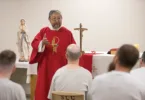
St. Camillus Church in Silver Spring, Md., is seen April 10. (CNS photo/Tyler Orsburn)
by Chris Byrd
NEW YORK (CNS) — Deeply moving and richly satisfying, the unusually fine documentary “Look & See: Wendell Berry’s Kentucky” debuts on PBS stations Monday, April 23, 10-11 p.m. EDT, as part of the network’s “Independent Lens” series.
Save for a single strong profanity, the film contains nothing objectionable. Thus it can be endorsed for mature teens as well as adults.
Filmmaker Laura Dunn and executive producers Robert Redford and Terrence Malick, the trio that collaborated on Dunn’s first feature documentary, 2007’s “The Unforeseen” — itself inspired by Berry’s poem “Sabbaths III” — reunites for this project. Redford is, of course, a Hollywood legend while Malick has had his own storied career as a director, beginning with 1973’s “Badlands.”
Largely told from its 83-year-old subject’s insightful perspective, “Look & See” makes for weighty, challenging viewing as it chronicles the deleterious effects technological changes have had on U.S. agriculture and the lives of small farmers. These negative consequences have been so severe that the prolific author now considers rural America on a par with the Third World.
A poet, novelist and essayist, Berry has published more than 40 books in a career spanning almost six decades. His work has been strongly influenced by the high regard in which he holds the message of the Gospels.
In 1965, after a writing apprenticeship during which Berry and his wife, Tanya, whom he married in 1957, traveled extensively, the sixth-generation Kentuckian made the critical decision to return his native Henry County, where his father, John, had raised tobacco.
Berry became a corn and grain farmer, and he and Tanya chose to raise their children in the Blue Grass State because, as Tanya says, they could “be somewhere where they belong.” “It wasn’t perfect,” she observes, “but it was right.”
Forming an intimate connection with the land, Berry became a widely known environmental activist. His advocacy eventually earned him the nickname “the prophet of rural America.”
As Catholic viewers in particular will note, Berry’s concerns about technology’s harmful impact — as well as his belief in people’s need to stay closely linked to nature — echo themes found in Pope Francis’ 2015 encyclical “Laudato Si’.”
Dunn frames her documentary as a writer would a book, with each of its six sections getting a chapter heading, such as “Imagination in Place” and “The Handing Down.” Some interviews with family members and local farmers are also included.
Archival film footage, wood engravings by artist Wesley Bates along with intimate and arresting black-and-white photographs also enhance the documentary.
But the program chiefly belongs to Berry and his subtly powerful and evocative words. He eloquently decries the economy created by the rise of large agribusiness firms which, when it “meets the landscape,” becomes “violent, toxic … community destroying and family destroying.”
Beyond the man and his message, there’s more to admire about “Look & See.” Dunn’s direction, though unhurried, nonetheless wonderfully distills her topic’s essence.
Lee Daniel’s exquisite cinematography strikingly captures Berry’s picturesque surroundings. And Kerry Muzzey’s musical score swells to a crescendo that well complements the message of the documentary’s hopeful coda: the land’s hardship is also its possibility.
With an overall warning viewers will ignore at their peril, this gem of a film is not to be missed.







I know Mr.& Mrs. Berry. Fine people, few times we have ment always kind to me.